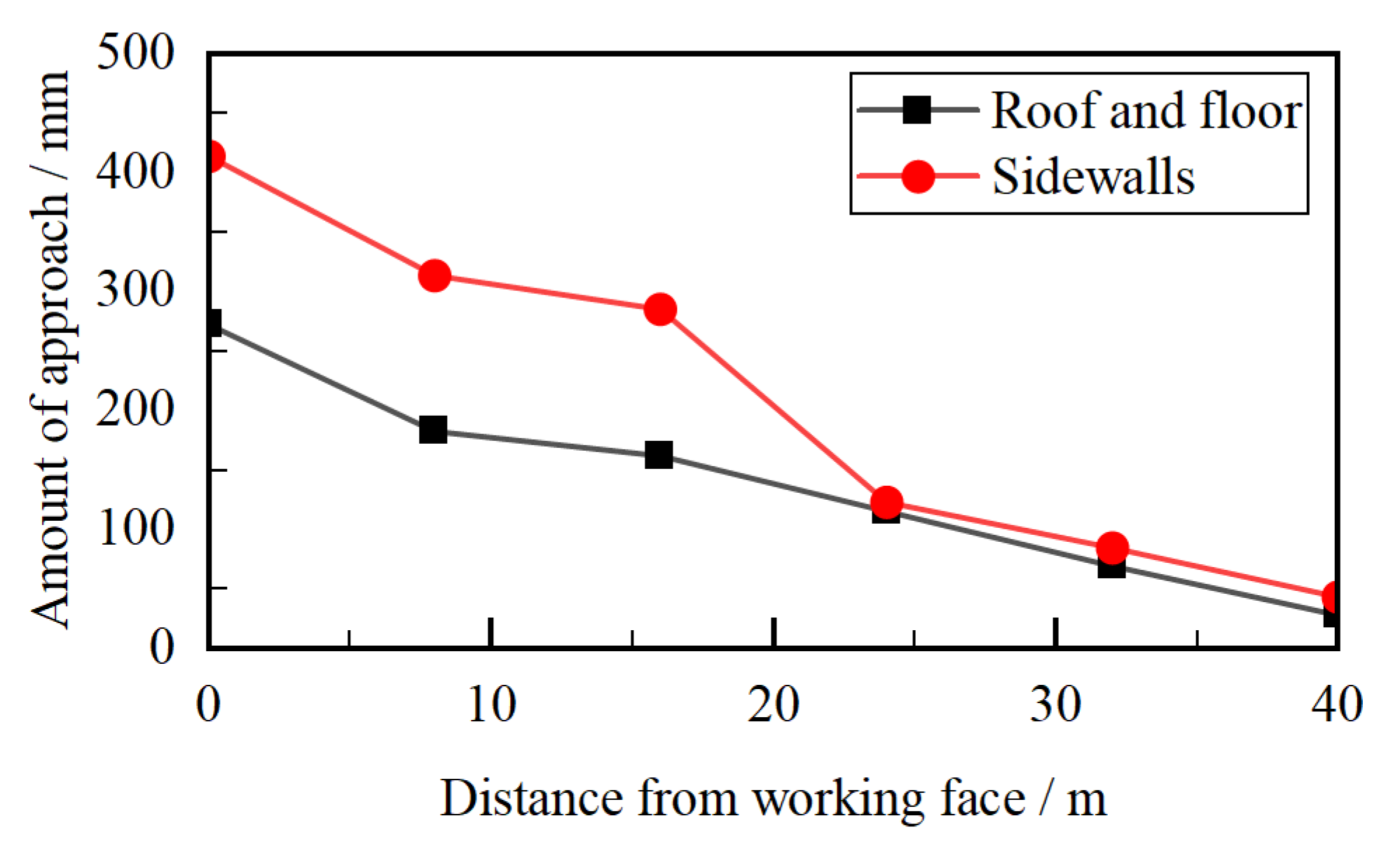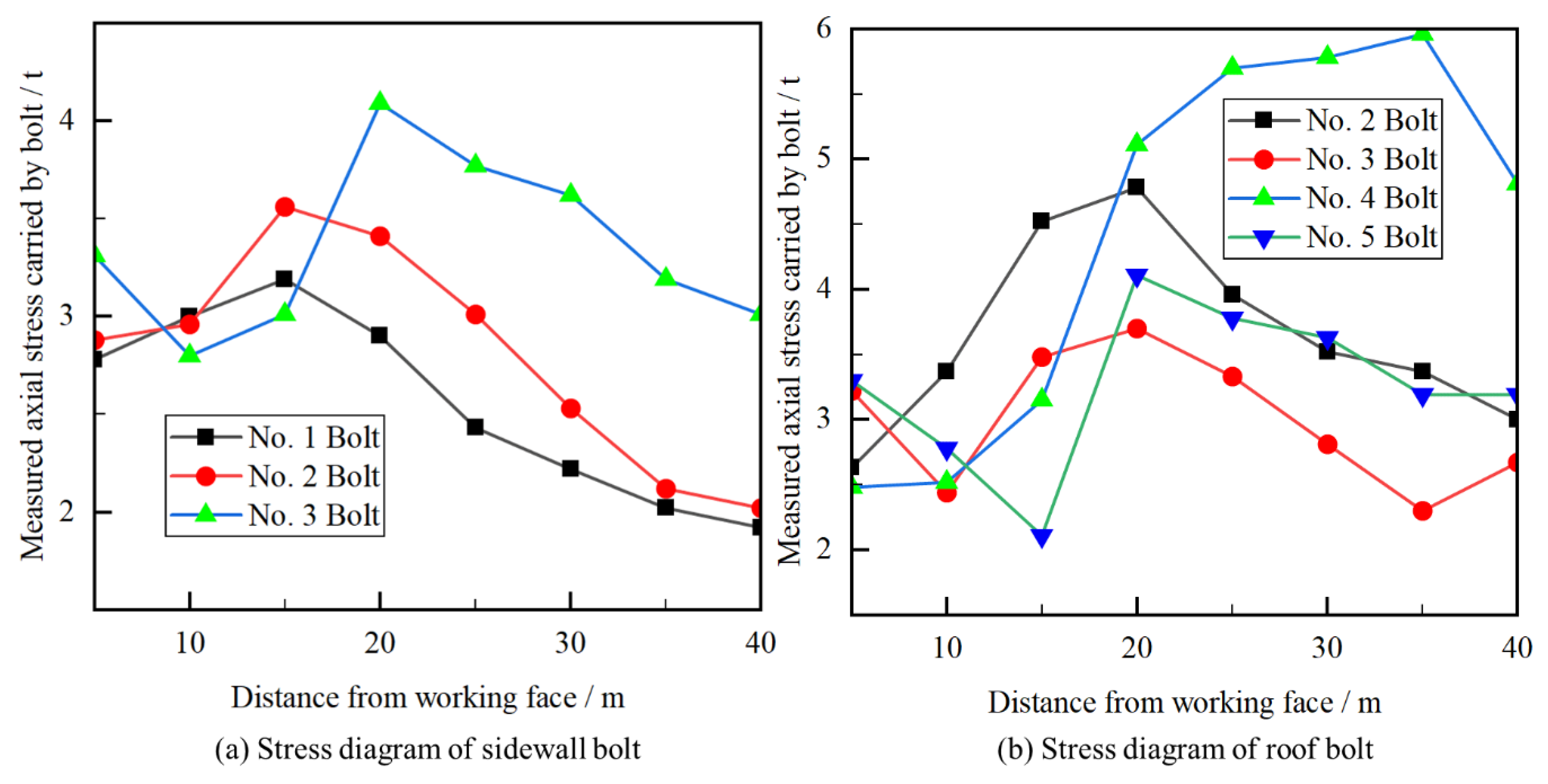Study on the Mechanism of a Hanging Roof at a Difficult Caving End in a Fully-Mechanized Top Coal Caving Face
Abstract
1. Introduction
2. Background
2.1. Mining Conditions of the Working Face
2.2. Roadway Support Parameters
3. Study on the Law of Ground Pressure Behavior in the Working Face
3.1. Deformation Characteristics of Surrounding Rock in a Mining Roadway
3.2. Roof Failure Characteristics of the Mining Roadway
3.3. Stress Characteristics of the Bolt in the Mining Roadway
3.4. Working Face End Hanging Structure Characteristics
4. Study on Working Face End Hanging Roof
4.1. Theoretical Calculation of Failure Depth and Breaking Distance
4.2. Numerical Simulation of Working Face End Hanging Structure
4.3. Analysis of Numerical Simulation Results
4.3.1. Plastic Zone and Stress Variation of the Roadway Surrounding the Rock in Front of the Working Face
4.3.2. Plastic Zone and Stress Change of the Roadway Surrounding the Rock behind the Working Face
5. Discussion
5.1. Caving Condition Analysis of Working Face End Hanging Roof Structure
5.2. The Mechanism of Working Face End Hanging Roof
6. Conclusions
Author Contributions
Funding
Institutional Review Board Statement
Informed Consent Statement
Data Availability Statement
Acknowledgments
Conflicts of Interest
References
- Qian, M.; Xu, J. Study on the “o-shape” circle distribution charactheristics of mining-induced fractures in the over-laying strata. J. China Coal Soc. 1998, 05, 20–23. [Google Scholar]
- Huang, B.; Cheng, Q.; Zhao, X.; Xue, W.; Scoble, M. Using hydraulic fracturing to control caving of the hanging roof during the initial mining stages in a longwall coal mine: A case study. Arab. J. Geosci. 2018, 11, 603. [Google Scholar] [CrossRef]
- Liu, J.; Liu, C.; Yao, Q.; Si, G. The position of hydraulic fracturing to initiate vertical fractures in hard hanging roof for stress relief. Int. J. Rock Mech. Min. Sci. 2020, 132, 104328. [Google Scholar] [CrossRef]
- Brodny, J.; Tutak, M. Exposure to Harmful Dusts on Fully Powered Longwall Coal Mines in Poland. Int. J. Environ. Res. Public Health 2018, 15, 1846. [Google Scholar] [CrossRef] [PubMed]
- Zang, C.W.; Zhuang, X.; Le Ma, C. Research of Large-Area Hard Roof Caving Prevention and Control System in Shortwall Mining Face. Adv. Mater. Res. 2013, 734–737, 802–808. [Google Scholar] [CrossRef]
- Qian, M.; Shi, P. Ground Pressure and Strata Control; China University of Mining and Technology Press: Xuzhou, China, 2010. [Google Scholar]
- Du, J.; Meng, X. Mining Technology; China University of Mining and Technology Press: Xuzhou, China, 2014. [Google Scholar]
- Zhang, G. Ventilation and Safety Technology; China University of Mining and Technology Press: Xuzhou, China, 2011. [Google Scholar]
- Li, C.; Li, S. Roof control technology for large unsupported roof at face end of coal mining face. Coal Sci. Technol. 2008, 8, 26–30. [Google Scholar]
- Tan, Y.-L.; Zhang, L.-J. Gob-Side Entry with Limestone Roof Retained by Anchorage Cable and Individual Prop Support. Con-trolling Seismic Hazard and Sustainable Development of Deep Mines. In Proceedings of the 7th International Symposium on Rockburst and Seismicity in Mines (rasim7), Dalian, China, 21–23 August 2009; Rinton Press, Inc.: Princeton, NJ, USA, 2009; Volumes 1 and 2, pp. 143–148. [Google Scholar]
- Huang, B.; Wang, Y. Roof Weakening of Hydraulic Fracturing for Control of Hanging Roof in the Face End of High Gassy Coal Longwall Mining: A Case Study. Arch. Min. Sci. 2016, 61, 601–615. [Google Scholar] [CrossRef]
- Kai, W. Study of Reasonable Hanging Roof Length on Hard Roof. Procedia Eng. 2011, 26, 772–777. [Google Scholar] [CrossRef][Green Version]
- He, F.; Wang, L.; Yu, Y. Hanging roof rock beam model and its rheological analysis in goaf. Mine Press. Roof Manag. 2005, 04, 84–85+88. [Google Scholar] [CrossRef]
- Wang, Z.; Wang, Y.; Li, J. Creep analysis of hanging roof beam model of empty region after excavation. J. Liaoning Tech. Univ. 2007, 26, 83–85. [Google Scholar]
- Wang, J.; Gong, S.; Zhou, S. Analsis of structure of hanging triangle roof plate with curve side in fully-mechanized sublevel caving face. China Coal Industry 2012, 38, 36–40. [Google Scholar] [CrossRef]
- Qin, L.; Zhang, L. Study on Structure and Stability of End Roof of Fully Mechanized Caving Face. Mod. Coal Mines 2000, 06, 14–16. [Google Scholar] [CrossRef]
- Luan, H.; Lin, D.; Jia, C.; Sun, R. Mechanisms of Strata Behaviors Periodicity for Gob-side Entry Retaining. J. Shandong Univ. Sci. Technol. Nat. Sci. 2014, 33, 60–64. [Google Scholar] [CrossRef]
- Yang, P.; Liu, C. Structure Forms of Basic Roof and Reasonable Supporting Parameters in Ends of Fully-Mechanized Top Caving Face. J. Min. Saf. Eng. 2012, 29, 26–32. [Google Scholar] [CrossRef]
- Yang, J.; Liu, C.; Yu, B.; Wu, F. An analysis on strong strata behaviors and stress transfer of the roadway ap-proaching gob in triangle area of the face end. J. Min. Saf. Eng. 2016, 33, 88–95. [Google Scholar] [CrossRef]
- Xu, Y. Structure coupling between hydraulic roof support and surrounding rock in extra-thick and hard coal seam with super large cutting height and longwall top coal caving operation. Ph.D. Thesis, China Coal Research Institute, Beijing, China, 2020. [Google Scholar] [CrossRef]
- Pavlova, L.D.; Fryanov, V.N.; Keller, A.V.; Tsvetkov, A.B. Numerical study of the effect of console length of the main roof hanging on the geomechanical parameters of the mine face. IOP Conf. Ser. Earth Environ. Sci. 2019, 377, 012037. [Google Scholar] [CrossRef]
- Xue, J.; Ma, Q.; Du, X.; Zhan, K.; Sun, B. Numerical simulation and control of a rockburst induced by main roof fracture in a deep coal seam. Energy Sources Part A Recover. Util. Environ. Eff. 2020, 1–17. [Google Scholar] [CrossRef]
- Dychkovskyi, R.; Shavarskyi, I.; Saik, P.; Lozynskyi, V.; Falshtynskyi, V.; Cabana, E. Research into stress-strain state of the rock mass condition in the process of the operation of double-unit longwalls. Min. Miner. Depos. 2020, 14, 85–94. [Google Scholar] [CrossRef]
- Vu, T.T. Solutions to prevent face spall and roof falling in fully mechanized longwall at underground mines, Vietnam. Min. Miner. Depos. 2022, 16, 127–134. [Google Scholar] [CrossRef]
- Chen, B.; Liu, C.; Wang, B. A case study of the periodic fracture control of a thick-hard roof based on deep-hole pre-splitting blasting. Energy Explor. Exploit. 2021, 40, 279–301. [Google Scholar] [CrossRef]
- Liu, C.; Yang, Z.; Gong, P.; Wang, K.; Zhang, X.; Zhang, J.; Li, Y. Accident Analysis in Relation to Main Roof Structure When Longwall Face Advances toward a Roadway: A Case Study. Adv. Civ. Eng. 2018, 2018, 3810315. [Google Scholar] [CrossRef]
- Li, P.; Zheng, X.; Guo, X.; Li, B.; Wang, C. Application of the Ultimate Hanging Arch Length of the Layered Roof with Anchors and the Gob-Side Entry Retaining. Shock Vib. 2021, 2021, 4338686. [Google Scholar] [CrossRef]
- Dai, J.; Li, H.; Jiang, J. Elastic analysis hanging triangle roof plate with curve side on the end of sub-level caving mining face. Chin. J. Rock Mech. Eng. 2004, 23(S2), 4757–4760. [Google Scholar] [CrossRef]













| Rock Stratum | STA 1-20 | STA-40 | STA-60 | STA-80 | STA-100 | |||||
|---|---|---|---|---|---|---|---|---|---|---|
| D 2 /m | GT 3 /m | D /m | GT /m | D /m | GT /m | D /m | GT /m | D /m | GT /m | |
| Fine sandstone | 0.9 | 8 | 0.9 | 8 | 1.3 | 8 | 1.2 | 8 | 0.9 | 8 |
| Sand mudstone | 4.1 | 7.1 | 3.6 | 7.1 | 4 | 6.7 | 4 | 6.8 | 4.1 | 7.1 |
| Coal | 3 | 3 | 3.5 | 3.5 | 2.7 | 2.7 | 2.8 | 2.8 | 3 | 3 |
| Surrounding Rock | Thickness/m | Elastic Modulus /GPa | Poisson’s Ratio | Cohesion /MPa | Internal Friction Angle/° | Dilation Angle/° | Density /kg/m3 | Tensile Strength /MPa |
|---|---|---|---|---|---|---|---|---|
| Overlying strata | 40 | 11.3 | 0.33 | 10.71 | 30.5 | 7.63 | 2550 | 2.8 |
| Mudstone | 4.5 | 11.5 | 0.17 | 8.60 | 32 | 8 | 2500 | 3.8 |
| Fine sandstone | 2 | 12.5 | 0.38 | 16.34 | 35.6 | 8.9 | 2950 | 7.52 |
| Sand mudstone | 4 | 12.18 | 0.18 | 9.15 | 33.49 | 8.37 | 2660 | 6.50 |
| No. 2 Coal | 6.5 | 2.37 | 0.26 | 2.21 | 34.14 | 8.54 | 1390 | 0.78 |
| Sand mudstone | 2 | 12.8 | 0.15 | 9.10 | 32.2 | 8.05 | 2650 | 4.18 |
| No. 3 Coal | 1 | 4.1 | 0.41 | 2.56 | 36.3 | 9.08 | 2750 | 1.38 |
| Mudstone | 1 | 11.5 | 0.17 | 8.60 | 32 | 8 | 2500 | 3.8 |
| Sand mudstone | 3 | 12.8 | 0.15 | 9.10 | 32.2 | 8.05 | 2650 | 4.18 |
| Fine sandstone | 5 | 12.5 | 0.38 | 16.34 | 35.6 | 8.9 | 2950 | 7.52 |
| Sand mudstone | 3 | 12.18 | 0.18 | 9.15 | 33.49 | 8.37 | 2660 | 6.50 |
| Fine sandstone | 8 | 12.5 | 0.38 | 16.34 | 35.6 | 8.9 | 2950 | 7.52 |
Disclaimer/Publisher’s Note: The statements, opinions and data contained in all publications are solely those of the individual author(s) and contributor(s) and not of MDPI and/or the editor(s). MDPI and/or the editor(s) disclaim responsibility for any injury to people or property resulting from any ideas, methods, instructions or products referred to in the content. |
© 2023 by the authors. Licensee MDPI, Basel, Switzerland. This article is an open access article distributed under the terms and conditions of the Creative Commons Attribution (CC BY) license (https://creativecommons.org/licenses/by/4.0/).
Share and Cite
Liu, H.; Hao, C.; Han, Z.; Liu, Q.; Wang, H.; Liang, J.; Zhang, D. Study on the Mechanism of a Hanging Roof at a Difficult Caving End in a Fully-Mechanized Top Coal Caving Face. Sustainability 2023, 15, 812. https://doi.org/10.3390/su15010812
Liu H, Hao C, Han Z, Liu Q, Wang H, Liang J, Zhang D. Study on the Mechanism of a Hanging Roof at a Difficult Caving End in a Fully-Mechanized Top Coal Caving Face. Sustainability. 2023; 15(1):812. https://doi.org/10.3390/su15010812
Chicago/Turabian StyleLiu, Hongtao, Cheng Hao, Zijun Han, Qinyu Liu, Haozhu Wang, Jialu Liang, and Dandan Zhang. 2023. "Study on the Mechanism of a Hanging Roof at a Difficult Caving End in a Fully-Mechanized Top Coal Caving Face" Sustainability 15, no. 1: 812. https://doi.org/10.3390/su15010812
APA StyleLiu, H., Hao, C., Han, Z., Liu, Q., Wang, H., Liang, J., & Zhang, D. (2023). Study on the Mechanism of a Hanging Roof at a Difficult Caving End in a Fully-Mechanized Top Coal Caving Face. Sustainability, 15(1), 812. https://doi.org/10.3390/su15010812







